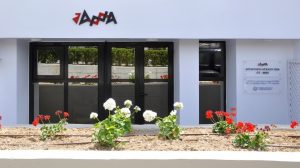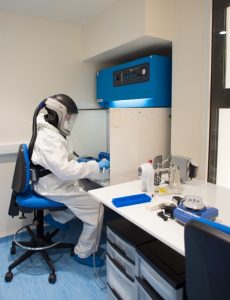Facility type: FIXLAB
Access provider: Laboratory of Ancient DNA (DNA), IMBB, FORTH
Title: Archaeogenomics – Paleogenomics
Description
The main goal of the Ancient DNA facility at FORTH (Ancient DNA Lab – FORTH-IMBB) is to develop collaborative research between the humanities and the natural sciences and to provide the means to harness the biological excavation findings that remain unexploited. The Ancient DNA Lab of FORTH-IMBB complies fully with the strict guidelines that are followed by forensic laboratories, in order to ensure the analyses reliability.
The Ancient DNA applications include:
- Determination of the genetic sex in individuals with non-diagnosable skeletal sex characteristics
- Association between observed skeletal pathologies in ancient individuals and specific genetic diseases
- Tracing of ancient microbial pathogens and studying ancient epidemic events
- Reconstruction of specific phenotypic characters in ancient individuals
- Study of the diet, public health, and economies during the ancient times
- Assignment of individuals to population genetic groups based on their matrilineal or patrilineal ancestry
- Palaeogenomics of extinct species and molecular identification of the species
- Inferring the kinship among a group of individuals and the study of relatedness issues
- Unravelling the origin of human species and the relationships among the extinct members of the human genus
- Studying the relationships, admixture and dispersal events among ancient populations
- Continuity and genetic relationships between ancient and contemporary human populations
- Evidence of adaptation and natural selection in human traits
- Genetic manifestation of domestication on animals and plants
Services
Ancient DNA Wetlab Services,
DNA Extraction
- Ancient DNA can be successfully recovered from a wide range of bioarcheological materials, including bone, teeth, desiccated and mummified soft tissues, paleofeces, hair, dental calculus, seeds and other plant material, cultural objects, and sediments, among others. Efficient protocols for recovering ultrashort DNA fragments from archaeological sources have been developed.
High-throughput sequencing library construction
- Library refers to the end product of a suite of synthetic modifications made to the DNA in order to make it “readable” by sequencing instruments. Optimized for ancient DNA library construction protocols have been developed including robust protocols for both double-stranded and single-stranded DNA libraries, as well as the use of single- or dual-indexing to perform parallel sequencing of multiple samples in the same run. Quick and easy, double-stranded library preps are suitable for most archaeological samples with average to good preservation, whereas single-stranded library preps are used to recover DNA from marginal samples from warm climates or deep time.
Targeted enrichment (DNA sequence capture)
- This service includes methods to selectively recover genomic regions of interest from ancient samples. The goal of capture is to “fish-out” desired DNA sequences from a sea of unwanted (usually environmental) DNA so that less sequencing effort and cost is needed to obtain the desired genetic information.
Ancient DNA Bioinformatics Services
- There are numerous analyses that can be performed by utilizing ancient DNA data generated with Next Generation Sequencing (NGS) platforms. Most analyses are similar to those conducted using NGS data from modern samples. However, they require either the use of software tools dedicated to aDNA data because they take into account specific characteristics of the aDNA sequences, or the selection of different parameters when using software tools that handle both modern and ancient DNA data.
Analyses Overview
- Sequencing data quality metrics
- Trimming of adapters and raw sequence data filtering
- Filtered sequencing data quality metrics
- Mapping to reference genome and mapping statistics generation
- Local realignment of indels
- Damage estimation
- Contamination estimation based on mtDNA
- Genetic sex estimation
- Contamination estimation based on chromosome X in males
- Contamination removal
- Matrilineal ancestry determination (Mitochondrion)
- Patrilineal ancestry determination (Y chromosome)
- Kinship analysis
- Calling or imputing of selected SNPs associated with phenotypes or genetic diseases
- Population clustering analysis
- Admixture analysis
- Phylogenetic analysis
- Metagenomics analysis
Technical Info
Technical standards of the Ancient DNA facility.
The Ancient DNA Lab is one of the most modern laboratories in Europe, it has been constructed under the highest technical standards and it complies totally with the strict, international requirements of forensic labs:
- Isolated building. The lab is located in a building isolated from other laboratories that analyze DNA (DNA-free building), whereas all the construction materials have non-biological origin.
- Restricted and supervised access. The access in the lab is restricted only to the specialized staff.
- Appropriate room arrangement. The lab rooms are properly designed and arranged following a gradient of cleanness in order to minimize the transportation of DNA from the environment to the cleanroom and the samples. For this reason, there is gradual atmospheric pressure among the rooms.
- Ventilation via HEPA filters. The lab is equipped with HEPA (High Efficiency Particulate Air) filters that are able to remove microparticles and allergens with high efficiency (99.97% of particles bigger than 300 nm).
- Sterilization. The lab rooms and its equipment is sterilized after each use with specialized chemical agents and in everyday basis using an automatic UV-light mechanism.
- Removal of pollutants and fumes. Special mechanisms are used to discard pollutants originated from sample drilling, as well as reagent fumes.
- Exclusive equipment. The equipment of the lab is new and is used exclusively to analyze ancient DNA.
- Clothing. All the clothing consists of materials of non-biological origin. It includes suits, masks, foot protection, boots, boot covers, sleeves, gloves, eye-shields etc. in order to avoid or minimize sample contamination with exogenous DNA.
- Consumables. All the consumables are of forensic grade and stand for the highest quality and purity.
- Sample handling – Protocols. Both sample handling and protocols used are following the standard and certified procedures of ancient DNA analysis, in order to minimize contamination and at the same time to maximize the potential of extracting the most reliable results and conclusions.
Bioinformatics tools: bcl2fastq2, FastQC, MultiQC, AdapterRemoval, Cutadapt, Seqtk, Seqkit, BWA, Bowtie, SAMtools, Picard, Qualimap, Tablet, PreSeq, GATK, mapDamage, PMDtools, schmutzi, ANGSD, dice, Ry_compute.py, Rx_identifier.R, SEXCMD, HaploGrep, HAPLOFIND, Bcftools, VCFtools, BEDtools, Yfitter, Yleaf, Yhaplo, READ, NgsRelate, BEAGLE, PLINK, EIGENSOFT, ADMIXTURE, ADMIXtools, Dsuite, TreeMix, MAFFT, MEGA, RAxML, MrBayes, MALT, MEGAN, Kraken, kraken-tools, Krona-tools, Krona
Examples/Photos
|
|
|
Related Publications
……………….
Related info
https://www.ancient-dna.gr/index.php/en/


